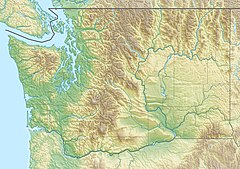Geography of Washington (state)
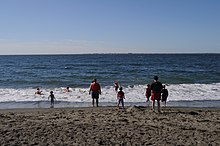
Washington is the northwesternmost state of the contiguous United States. It borders Idaho to the east, bounded mostly by the meridian running north from the confluence of the Snake River and Clearwater River (about 117°02'23" west), except for the southernmost section where the border follows the Snake River. Oregon is to the south, with the Columbia River forming the western part and the 46th parallel forming the eastern part of the Oregon–Washington border. During Washington's partition from Oregon, the original plan for the border followed the Columbia River east until the confluence with the Snake river, and then would have followed the Snake River east; this was changed to keep Walla Walla's fertile farmland in Washington.
To the west of Washington lies the Pacific Ocean.[1] Its northern border lies mostly along the 49th parallel, and then via marine boundaries through the Strait of Georgia, Haro Strait, and Strait of Juan de Fuca, with the Canadian province of British Columbia to the north.[2]
Overview
[edit]Washington is part of a region known as the Pacific Northwest, a term which always refers to at least Washington and Oregon, and may or may not include some or all the following, depending on the user's intent: Idaho, western Montana, northern California, British Columbia, and Alaska.
The high mountains of the Cascade Range run north–south, bisecting the state. In addition to Western Washington and Eastern Washington, residents call the two parts of the state the "Westside" and the "Eastside", "Wet side" and "Dry side", or "Timberland" and "Wheatland", the latter pair more commonly in the names of region-specific businesses and institutions. These terms reflect the geography, climate, and industry of the land on both sides of the Cascades.
Western Washington
[edit]|
Geography of Washington (state) (Washington (state)) |
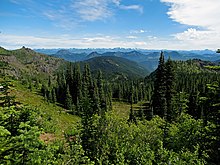
From the Cascade Mountains westward, Western Washington has a mostly Mediterranean climate, with mild temperatures and wet winters, autumns and springs, and relatively dry summers. The Cascade Range has several volcanoes, which reach altitudes significantly higher than the rest of the mountains. From north to south, these major volcanoes are Mount Baker, Glacier Peak, Mount Rainier, Mount St. Helens, and Mount Adams. All are active volcanoes.[3]
Mount Rainier—the tallest mountain in the state—[4] is 50 miles (80 km) south of the city of Seattle, from which it is prominently visible. The U.S. Geological Survey considers 14,411-foot-tall (4,392 m) Mount Rainier the most dangerous volcano in the Cascade Range, due to its proximity to the Seattle metropolitan area, and most dangerous in the continental U.S. according to the Decade Volcanoes list.[5] It is also covered with more glacial ice than any other peak in the contiguous 48 states.[6]
Western Washington also is home of the Olympic Mountains, far west on the Olympic Peninsula, which support dense forests of conifers and areas of temperate rainforest. These deep forests, such as the Hoh Rainforest, are among the only rainforests in the continental United States.[7] While Western Washington does not always experience a high amount of rainfall as measured in total inches of rain per year, it does consistently have more rainy days per year than most other places in the country.[8]
Eastern Washington
[edit]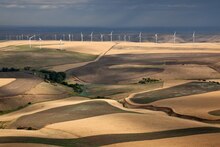
Eastern Washington—the part of the state east of the Cascades—has a relatively dry climate, in distinct contrast to the west side. It includes large areas of semiarid steppe and a few truly arid deserts in the rain shadow of the Cascades; the Hanford reservation receives an average annual precipitation of 6 to 7 inches (150 to 180 mm). Despite the limited amount of rainfall, agriculture is an extremely important business throughout much of Eastern Washington, as the soil is highly productive and irrigation, aided by dams along the Columbia River, is fairly widespread.[9] The spread of population in Eastern Washington is dominated by access to water, especially rivers. The main cities are all located alongside rivers or lakes; most of them are named after the river or lake they adjoin.
Farther east, the climate becomes less arid, with annual rainfall increasing as one goes east to 21.2 inches (540 mm) in Pullman, near the Washington–Idaho border.[10] The Okanogan Highlands and the rugged Kettle River Range and Selkirk Mountains cover much of the state's northeastern quadrant. The Palouse southeast region of Washington was grassland that has been mostly converted into farmland, and extends to the Blue Mountains.[11]
Climate
[edit]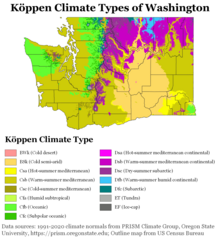
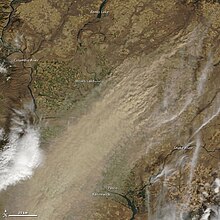
Major factors determining Washington's climate include the large semi-permanent high pressure and low pressure systems of the north Pacific Ocean, the continental air masses of North America, and the Olympic and Cascade mountains. In the spring and summer, a high-pressure anticyclone system dominates the north Pacific Ocean, causing air to spiral out in a clockwise fashion. For Washington, this means prevailing winds from the northwest bring relatively cool air and a predictably dry season.[13][failed verification]
In the autumn and winter, a low-pressure cyclone system takes over in the north Pacific Ocean. The air spiraling inward in a counter-clockwise fashion causes Washington's prevailing winds to come from the southwest, and bring relatively warm and moist air masses and a predictably wet season. The term "Pineapple Express" is used colloquially to describe atmospheric river events, where repeated storm systems are directed by this persistent cyclone from tropical and near-tropical Pacific regions into the Pacific Northwest.[14]
Despite Western Washington's marine climate similar to many coastal cities of Europe, there are exceptions such as the "Big Snow" events of 1880, 1881, 1893, and 1916,[15][16] and the "deep freeze" winters of 1883–1884, 1915–1916, 1949–1950, and 1955–1956, among others.[17] During these events, Western Washington experienced up to 6 feet (1.8 m) of snow, sub-zero (−18 °C) temperatures, three months with snow on the ground, and lakes and rivers frozen over for weeks.[16] Seattle's lowest officially recorded temperature is 0 °F (−18 °C) set on January 31, 1950, but low-altitude areas approximately three hours away from Seattle have recorded lows as cold as −48 °F (−44 °C).[18]
The Southern Oscillation greatly influences weather during the cold season. During the El Niño phase, the jet stream enters the U.S. farther south through California, therefore late fall and winter are drier than normal with less snowpack. The La Niña phase reinforces the jet stream through the Pacific Northwest, causing Washington to have more rain and snow than average.[19]
In 2006, the Climate Impacts Group at the University of Washington published The Impacts of Climate change in Washington's Economy, a preliminary assessment of the risks and opportunities presented given the possibility of a rise in global temperatures and their effects on Washington state.[20]
Rain shadow effects
[edit]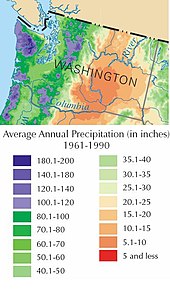
Rainfall in Washington varies dramatically going from east to west. The Olympic Peninsula's western side receives as much as 160 inches (4,100 mm) of precipitation annually, making it the wettest area of the 48 conterminous states and a temperate rainforest. Weeks may pass without a clear day. The western slopes of the Cascade Range receive some of the heaviest annual snowfall (in some places more than 200 inches or 5,100 millimeters water equivalent) in the country. In the rain shadow area east of the Cascades, the annual precipitation is only 6 inches (150 mm). Precipitation then increases again eastward toward the Rocky Mountains (about 120 miles (190 km) east of the Idaho border).
The Olympic mountains and Cascades compound this climatic pattern by causing orographic lift of the air masses blown inland from the Pacific Ocean, resulting in the windward side of the mountains receiving high levels of precipitation and the leeward side receiving low levels. This occurs most dramatically around the Olympic Mountains and the Cascade Range. In both cases, the windward slopes facing southwest receive high precipitation and mild, cool temperatures. While the Puget Sound lowlands are known for clouds and rain in the winter, the western slopes of the Cascades receive larger amounts of precipitation, often falling as snow at higher elevations.[21] Mount Baker, near the state's northern border, is one of the snowiest places in the world. In 1999, it set the world record for snowfall in a single season—1,140 inches (95 ft; 29 m).[22]
East of the Cascades, a large region experiences strong rain shadow effects. Semi-arid conditions occur in much of Eastern Washington with the strongest rain shadow effects at the relatively low elevations of the central Columbia Plateau—especially the region just east of the Columbia River from about the Snake River to the Okanagan Highland. Thus, instead of rain forests, much of Eastern Washington is covered with dry grassland, shrub-steppe, and dunes.
Temperatures
[edit]The average annual temperature ranges from 51 °F (11 °C) on the Pacific coast to 40 °F (4 °C) in the northeast. The lowest temperature recorded in the state was −48 °F (−44 °C) in Winthrop and Mazama. The highest recorded temperature in the state was 120 °F (49 °C) at Hanford on June 29, 2021.[23][24] Both records were set east of the Cascades. Western Washington is known for its mild climate, considerable fog, frequent cloud cover, long-lasting drizzles in the winter and warm, temperate summers. The eastern region, which does not benefit from the general moderating effect of the Pacific Ocean, occasionally experiences extreme climate. Arctic cold fronts in the winter and heat waves in the summer are not uncommon. In the Western region, temperatures have reached as high as 118 °F (48 °C) in Maple Valley[25] during the June 2021 heat wave, which was reported to be a 1000-year weather event and broke several records in the Pacific Northwest.[26][27] In Western Washington, they have also gone as low as −6 °F (−21 °C) in Longview.[28]
Climate data
[edit]| Climate data for Washington state (general) (1895–2015) | |||||||||||||
|---|---|---|---|---|---|---|---|---|---|---|---|---|---|
| Month | Jan | Feb | Mar | Apr | May | Jun | Jul | Aug | Sep | Oct | Nov | Dec | Year |
| Record high °F (°C) | 74 (23) |
83 (28) |
95 (35) |
103 (39) |
107 (42) |
120 (49) |
118 (48) |
118 (48) |
111 (44) |
99 (37) |
83 (28) |
74 (23) |
120 (49) |
| Mean maximum °F (°C) | 60 (16) |
64 (18) |
73 (23) |
86 (30) |
94 (34) |
102 (39) |
109 (43) |
106 (41) |
98 (37) |
84 (29) |
67 (19) |
60 (16) |
112 (44) |
| Mean daily maximum °F (°C) | 34.8 (1.6) |
40.6 (4.8) |
47.7 (8.7) |
55.9 (13.3) |
63.6 (17.6) |
69.9 (21.1) |
78.0 (25.6) |
77.3 (25.2) |
69.4 (20.8) |
57.2 (14.0) |
43.2 (6.2) |
36.2 (2.3) |
56.2 (13.4) |
| Mean daily minimum °F (°C) | 23.0 (−5.0) |
26.0 (−3.3) |
29.6 (−1.3) |
34.2 (1.2) |
40.1 (4.5) |
45.7 (7.6) |
50.5 (10.3) |
50.0 (10.0) |
44.7 (7.1) |
37.2 (2.9) |
29.9 (−1.2) |
25.3 (−3.7) |
36.4 (2.4) |
| Mean minimum °F (°C) | −19 (−28) |
−8 (−22) |
−2 (−19) |
14 (−10) |
21 (−6) |
26 (−3) |
31 (−1) |
31 (−1) |
24 (−4) |
16 (−9) |
2 (−17) |
−8 (−22) |
−20 (−29) |
| Record low °F (°C) | −42 (−41) |
−40 (−40) |
−25 (−32) |
−7 (−22) |
11 (−12) |
20 (−7) |
22 (−6) |
20 (−7) |
11 (−12) |
−5 (−21) |
−29 (−34) |
−48 (−44) |
−48 (−44) |
| Average precipitation inches (mm) | 6.08 (154) |
4.61 (117) |
4.23 (107) |
2.87 (73) |
2.31 (59) |
1.89 (48) |
0.85 (22) |
1.02 (26) |
1.93 (49) |
3.67 (93) |
6.22 (158) |
6.52 (166) |
42.2 (1,072) |
| Source 1: "Office of the Washington State Climatologist". OWSC. Retrieved July 27, 2016. | |||||||||||||
| Source 2: "Comparative Data for the Western States". WRCC. Archived from the original on July 29, 2016. Retrieved July 27, 2016. | |||||||||||||
| Place | Jan | Feb | Mar | Apr | May | Jun | Jul | Aug | Sep | Oct | Nov | Dec |
|---|---|---|---|---|---|---|---|---|---|---|---|---|
| Bellingham[29] | 48 / 36 (9 / 2) |
50 / 36 (10 / 2) |
54 / 39 (12 / 4) |
59 / 42 (15 / 6) |
64 / 47 (18 / 8) |
69 / 51 (21 / 11) |
73 / 54 (23 / 12) |
74 / 54 (23 / 12) |
68 / 50 (20 / 10) |
59 / 45 (15 / 7) |
51 / 39 (11 / 4) |
46 / 35 (8 / 2) |
| Ephrata[30] | 35 / 22 (2 / −6) |
43 / 26 (6 / −3) |
54 / 32 (12 / 0) |
63 / 38 (17 / 3) |
72 / 46 (22 / 8) |
80 / 54 (27 / 12) |
88 / 60 (31 / 16) |
87 / 59 (31 / 15) |
78 / 50 (26 / 10) |
62 / 39 (17 / 4) |
45 / 29 (7 / −2) |
34 / 21 (1 / −6) |
| Forks[31] | 47 / 36 (8 / 2) |
49 / 35 (9 / 2) |
51 / 37 (11 / 3) |
55 / 39 (13 / 4) |
60 / 43 (16 / 6) |
63 / 48 (17 / 9) |
67 / 51 (19 / 11) |
69 / 51 (21 / 11) |
66 / 47 (19 / 8) |
58 / 42 (14 / 6) |
50 / 38 (10 / 3) |
46 / 35 (8 / 2) |
| Paradise[32] | 35 / 23 (2 / −5) |
36 / 22 (2 / −6) |
38 / 24 (3 / −4) |
42 / 26 (6 / −3) |
49 / 32 (9 / 0) |
55 / 36 (13 / 2) |
63 / 43 (17 / 6) |
65 / 44 (18 / 7) |
58 / 40 (14 / 4) |
48 / 33 (9 / 1) |
37 / 25 (3 / −4) |
34 / 21 (1 / −6) |
| Richland[33] | 41 / 29 (5 / −2) |
47 / 30 (8 / −1) |
58 / 35 (14 / 2) |
65 / 41 (18 / 5) |
73 / 48 (23 / 9) |
80 / 54 (27 / 12) |
88 / 59 (31 / 15) |
88 / 58 (31 / 14) |
78 / 50 (26 / 10) |
64 / 40 (18 / 4) |
49 / 34 (9 / 1) |
38 / 27 (3 / −3) |
| Seattle[34] | 47 / 37 (8 / 3) |
50 / 37 (10 / 3) |
54 / 39 (12 / 4) |
59 / 42 (15 / 6) |
65 / 47 (18 / 8) |
70 / 52 (21 / 11) |
76 / 56 (24 / 13) |
76 / 56 (24 / 13) |
71 / 52 (22 / 11) |
60 / 46 (16 / 8) |
51 / 40 (11 / 4) |
46 / 36 (8 / 2) |
| Spokane[35] | 35 / 24 (2 / −4) |
40 / 25 (4 / −4) |
49 / 31 (9 / −1) |
57 / 36 (14 / 2) |
67 / 43 (19 / 6) |
74 / 50 (23 / 10) |
83 / 55 (28 / 13) |
83 / 55 (28 / 13) |
73 / 46 (23 / 8) |
58 / 36 (14 / 2) |
42 / 29 (6 / −2) |
32 / 22 (0 / −6) |
| Vancouver[36] | 47 / 33 (8 / 1) |
51 / 33 (11 / 1) |
56 / 37 (13 / 3) |
60 / 40 (16 / 4) |
67 / 45 (19 / 7) |
72 / 50 (22 / 10) |
78 / 54 (26 / 12) |
79 / 53 (26 / 12) |
75 / 48 (24 / 9) |
63 / 41 (17 / 5) |
52 / 37 (11 / 3) |
46 / 32 (8 / 0) |
| Winthrop[37] | 31 / 15 (−1 / −9) |
39 / 18 (4 / −8) |
51 / 26 (11 / −3) |
62 / 32 (17 / 0) |
71 / 40 (22 / 4) |
78 / 46 (26 / 8) |
86 / 50 (30 / 10) |
86 / 49 (30 / 9) |
78 / 41 (26 / 5) |
62 / 32 (17 / 0) |
42 / 25 (6 / −4) |
29 / 14 (−2 / −10) |
| Yakima[38] | 39 / 23 (4 / −5) |
46 / 26 (8 / −3) |
56 / 30 (13 / −1) |
64 / 34 (18 / 1) |
72 / 42 (22 / 6) |
80 / 48 (27 / 9) |
88 / 53 (31 / 12) |
87 / 52 (31 / 11) |
78 / 44 (26 / 7) |
64 / 34 (18 / 1) |
48 / 27 (9 / −3) |
36 / 21 (2 / −6) |
This article needs to be updated. The reason given is: Some of this data is more than five years old; parts are more than 10 years old. (November 2024) |
| Month | Jan | Feb | Mar | Apr | May | Jun | Jul | Aug | Sep | Oct | Nov | Dec | Year |
|---|---|---|---|---|---|---|---|---|---|---|---|---|---|
| Record high °F (°C) | 67 (19) |
70 (21) |
79 (26) |
89 (32) |
93 (34) |
108 (42) |
103 (39) |
99 (37) |
98 (37) |
89 (32) |
74 (23) |
66 (19) |
108 (42) |
| Mean maximum °F (°C) | 57.0 (13.9) |
59.1 (15.1) |
66.4 (19.1) |
74.3 (23.5) |
81.9 (27.7) |
85.8 (29.9) |
91.2 (32.9) |
89.9 (32.2) |
84.1 (28.9) |
72.0 (22.2) |
61.6 (16.4) |
56.8 (13.8) |
94.1 (34.5) |
| Mean daily maximum °F (°C) | 48.0 (8.9) |
50.3 (10.2) |
54.2 (12.3) |
59.3 (15.2) |
66.3 (19.1) |
71.1 (21.7) |
77.4 (25.2) |
77.6 (25.3) |
71.6 (22.0) |
60.5 (15.8) |
52.1 (11.2) |
47.0 (8.3) |
61.3 (16.3) |
| Daily mean °F (°C) | 42.8 (6.0) |
44.0 (6.7) |
47.1 (8.4) |
51.3 (10.7) |
57.5 (14.2) |
62.0 (16.7) |
67.1 (19.5) |
67.4 (19.7) |
62.6 (17.0) |
53.8 (12.1) |
46.5 (8.1) |
42.0 (5.6) |
53.7 (12.1) |
| Mean daily minimum °F (°C) | 37.7 (3.2) |
37.7 (3.2) |
39.9 (4.4) |
43.3 (6.3) |
48.7 (9.3) |
53.0 (11.7) |
56.8 (13.8) |
57.2 (14.0) |
53.6 (12.0) |
47.0 (8.3) |
40.9 (4.9) |
37.1 (2.8) |
46.1 (7.8) |
| Mean minimum °F (°C) | 26.1 (−3.3) |
27.3 (−2.6) |
31.3 (−0.4) |
35.6 (2.0) |
40.6 (4.8) |
46.6 (8.1) |
51.5 (10.8) |
51.7 (10.9) |
45.8 (7.7) |
36.8 (2.7) |
29.2 (−1.6) |
25.4 (−3.7) |
21.5 (−5.8) |
| Record low °F (°C) | 0 (−18) |
1 (−17) |
11 (−12) |
29 (−2) |
28 (−2) |
38 (3) |
43 (6) |
44 (7) |
35 (2) |
28 (−2) |
6 (−14) |
6 (−14) |
0 (−18) |
| Average precipitation inches (mm) | 5.78 (147) |
3.76 (96) |
4.17 (106) |
3.18 (81) |
1.88 (48) |
1.45 (37) |
0.60 (15) |
0.97 (25) |
1.61 (41) |
3.91 (99) |
6.31 (160) |
5.72 (145) |
39.34 (999) |
| Average snowfall inches (cm) | 1.8 (4.6) |
2.2 (5.6) |
0.4 (1.0) |
0.0 (0.0) |
0.0 (0.0) |
0.0 (0.0) |
0.0 (0.0) |
0.0 (0.0) |
0.0 (0.0) |
0.0 (0.0) |
0.2 (0.51) |
1.7 (4.3) |
6.3 (16) |
| Average precipitation days (≥ 0.01 in) | 18.7 | 15.9 | 17.1 | 15.0 | 11.3 | 9.2 | 4.7 | 4.9 | 8.3 | 14.3 | 18.4 | 18.4 | 156.2 |
| Average snowy days (≥ 0.1 in) | 1.4 | 1.2 | 0.4 | 0.0 | 0.0 | 0.0 | 0.0 | 0.0 | 0.0 | 0.0 | 0.2 | 1.5 | 4.7 |
| Average relative humidity (%) | 78.0 | 75.2 | 73.6 | 71.4 | 68.9 | 67.1 | 65.4 | 68.2 | 73.2 | 78.6 | 79.8 | 80.1 | 73.3 |
| Average dew point °F (°C) | 33.1 (0.6) |
35.1 (1.7) |
36.3 (2.4) |
38.8 (3.8) |
43.5 (6.4) |
48.2 (9.0) |
51.4 (10.8) |
52.7 (11.5) |
50.2 (10.1) |
45.1 (7.3) |
38.8 (3.8) |
34.3 (1.3) |
42.3 (5.7) |
| Mean monthly sunshine hours | 69.8 | 108.8 | 178.4 | 207.3 | 253.7 | 268.4 | 312.0 | 281.4 | 221.7 | 142.6 | 72.7 | 52.9 | 2,169.7 |
| Percent possible sunshine | 25 | 38 | 48 | 51 | 54 | 56 | 65 | 64 | 59 | 42 | 26 | 20 | 49 |
| Average ultraviolet index | 1 | 2 | 3 | 5 | 6 | 7 | 7 | 6 | 5 | 3 | 1 | 1 | 4 |
| Source 1: NOAA (relative humidity, dew point and sun 1961–1990)[39][40][41] | |||||||||||||
| Source 2: Weather Atlas (UV)[42] | |||||||||||||
| Climate data for Spokane | |||||||||||||
|---|---|---|---|---|---|---|---|---|---|---|---|---|---|
| Month | Jan | Feb | Mar | Apr | May | Jun | Jul | Aug | Sep | Oct | Nov | Dec | Year |
| Record high °F (°C) | 62 (17) |
63 (17) |
74 (23) |
90 (32) |
97 (36) |
109 (43) |
108 (42) |
108 (42) |
98 (37) |
87 (31) |
70 (21) |
60 (16) |
109 (43) |
| Mean maximum °F (°C) | 48.2 (9.0) |
51.1 (10.6) |
63.0 (17.2) |
73.9 (23.3) |
84.0 (28.9) |
90.5 (32.5) |
97.5 (36.4) |
97.0 (36.1) |
89.2 (31.8) |
74.6 (23.7) |
56.4 (13.6) |
48.0 (8.9) |
99.1 (37.3) |
| Mean daily maximum °F (°C) | 34.5 (1.4) |
39.5 (4.2) |
48.6 (9.2) |
56.9 (13.8) |
67.1 (19.5) |
73.7 (23.2) |
84.4 (29.1) |
83.8 (28.8) |
73.6 (23.1) |
57.7 (14.3) |
42.3 (5.7) |
33.8 (1.0) |
58.0 (14.4) |
| Daily mean °F (°C) | 29.6 (−1.3) |
32.9 (0.5) |
40.0 (4.4) |
47.0 (8.3) |
56.0 (13.3) |
62.3 (16.8) |
71.0 (21.7) |
70.3 (21.3) |
61.1 (16.2) |
47.9 (8.8) |
36.3 (2.4) |
29.1 (−1.6) |
48.6 (9.2) |
| Mean daily minimum °F (°C) | 24.7 (−4.1) |
26.3 (−3.2) |
31.5 (−0.3) |
37.0 (2.8) |
44.9 (7.2) |
50.8 (10.4) |
57.6 (14.2) |
56.7 (13.7) |
48.6 (9.2) |
38.0 (3.3) |
30.3 (−0.9) |
24.3 (−4.3) |
39.2 (4.0) |
| Mean minimum °F (°C) | 4.4 (−15.3) |
9.8 (−12.3) |
18.5 (−7.5) |
26.4 (−3.1) |
32.7 (0.4) |
40.2 (4.6) |
45.9 (7.7) |
45.6 (7.6) |
35.4 (1.9) |
23.2 (−4.9) |
14.1 (−9.9) |
7.1 (−13.8) |
−3.0 (−19.4) |
| Record low °F (°C) | −30 (−34) |
−24 (−31) |
−10 (−23) |
14 (−10) |
24 (−4) |
33 (1) |
37 (3) |
35 (2) |
22 (−6) |
7 (−14) |
−21 (−29) |
−25 (−32) |
−30 (−34) |
| Average precipitation inches (mm) | 1.97 (50) |
1.44 (37) |
1.83 (46) |
1.25 (32) |
1.55 (39) |
1.17 (30) |
0.42 (11) |
0.47 (12) |
0.58 (15) |
1.37 (35) |
2.06 (52) |
2.34 (59) |
16.45 (418) |
| Average snowfall inches (cm) | 12.3 (31) |
7.8 (20) |
3.9 (9.9) |
0.7 (1.8) |
0.1 (0.25) |
0.0 (0.0) |
0.0 (0.0) |
0.0 (0.0) |
0.1 (0.25) |
0.5 (1.3) |
6.2 (16) |
13.8 (35) |
45.4 (115) |
| Average precipitation days (≥ 0.01 in) | 14.2 | 10.9 | 11.8 | 10.3 | 9.7 | 7.8 | 4.0 | 3.2 | 4.7 | 8.9 | 13.4 | 13.8 | 112.7 |
| Average snowy days (≥ 0.1 in) | 9.5 | 5.7 | 4.0 | 1.0 | 0.3 | 0.0 | 0.0 | 0.0 | 0.1 | 0.3 | 4.3 | 9.5 | 34.7 |
| Average relative humidity (%) | 82.5 | 79.1 | 70.3 | 61.0 | 58.2 | 53.9 | 44.0 | 45.0 | 53.9 | 66.6 | 82.7 | 85.5 | 65.2 |
| Mean monthly sunshine hours | 78.3 | 118.0 | 199.3 | 242.3 | 296.7 | 322.8 | 382.4 | 340.4 | 271.2 | 191.0 | 73.8 | 59.1 | 2,575.3 |
| Percent possible sunshine | 28 | 41 | 54 | 59 | 63 | 68 | 79 | 77 | 72 | 57 | 26 | 22 | 54 |
| Source: NOAA (relative humidity and sun 1961–1990)[43][44][45] | |||||||||||||
Flora and fauna
[edit]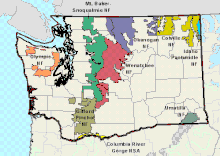
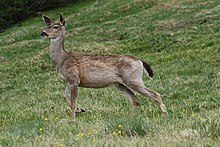
Forests cover about half the state's land area, mostly west of the northern Cascades. Approximately two-thirds of Washington's forested area is publicly owned, including 64 percent of federal land.[46] Common trees and plants in the region are camassia, Douglas fir, hemlock, penstemon, ponderosa pine, western red cedar, and many species of ferns.[47] The state's various areas of wilderness offer sanctuary, with substantially large populations of shorebirds and marine mammals. The Pacific shore surrounding the San Juan Islands is heavily inhabited by killer, gray, and humpback whales.[48]
In Eastern Washington, the flora is vastly different. Tumbleweeds and sagebrush dominate the landscape throughout large parts of the countryside. Russian olives and other trees are common alongside riverbanks; however, apart from the riversides, large swaths of Eastern Washington have no naturally existing trees at all (though many trees have been planted and are irrigated by people, of course). A wider variety of flora can be found in both the Blue Mountains and the eastern sides of the Cascades.
Mammals native to the state include the bat, black bear, bobcat, cougar, coyote, deer, elk, gray wolf, hare, moose, mountain beaver, muskrat, opossum, pocket gopher, rabbit, raccoon, river otter, skunk, and tree squirrel.[49] Because of the wide range of geography, the State of Washington is home to several different ecoregions, which allow for a varied range of bird species. This range includes raptors, shorebirds, woodland birds, grassland birds, ducks, and others.[50] There have also been a large number of species introduced to Washington, dating back to the early 18th century, including horses and burros.[51] The channel catfish, lamprey, and sturgeon are among the 400 known freshwater fishes.[52][53] Along with the Cascades frog, there are several forms of snakes that define the most prominent reptiles and amphibians.[54][55] Coastal bays and islands are often inhabited by plentiful amounts of shellfish and whales. There are five species of salmon that ascend the Western Washington area, from streams to spawn.[48]
Washington has a variety of National Park Service units. Among these are the Alta Lake State Park, Lake Roosevelt National Recreation Area, San Juan Islands National Wildlife Refuge, as well as three national parks—the Olympic National Park, North Cascades National Park, and Mount Rainier National Park.[56] The three national parks were established between 1899 and 1968. Almost 95 percent (876,517 acres, 354,714 hectares, 3,547.14 square kilometers) of Olympic National Park's area has been designated as wilderness under the National Wilderness Preservation System.[57] Additionally, there are 143 state parks and 9 national forests, run by the Washington State Park System and the United States Forest Service.[58] The Okanogan National Forest is the largest national forest on the West Coast, encompassing 1,499,023 acres (606,633 ha). It is managed together as the Okanogan–Wenatchee National Forest, encompassing a considerably larger area of around 3,239,404 acres (1,310,940 ha).[59]
Administrative divisions
[edit]There are 39 counties within the state, and 281 incorporated municipalities which are divided into cities and towns.[60] The majority of the state's population lives within Western Washington, in the Seattle metropolitan area; the city of Seattle is the principal city of the metropolitan area, and Western Washington, with a 2020 census population of 737,015.[61]
| Rank | Name | County | Pop. | ||||||
|---|---|---|---|---|---|---|---|---|---|
 Seattle  Spokane |
1 | Seattle | King | 737,015 |  Tacoma  Vancouver | ||||
| 2 | Spokane | Spokane | 228,989 | ||||||
| 3 | Tacoma | Pierce | 219,346 | ||||||
| 4 | Vancouver | Clark | 190,915 | ||||||
| 5 | Bellevue | King | 151,854 | ||||||
| 6 | Kent | King | 136,588 | ||||||
| 7 | Everett | Snohomish | 110,629 | ||||||
| 8 | Renton | King | 106,785 | ||||||
| 9 | Spokane Valley | Spokane | 102,976 | ||||||
| 10 | Federal Way | King | 101,030 | ||||||
See also
[edit]References
[edit]- ^ "Washington State Constitution—Article XXIV—Boundaries". Washington State Legislature. Archived from the original on July 24, 2019. Retrieved April 17, 2014.
- ^ "Britain and the United States agree on the 49th parallel as the main Pacific Northwest boundary in the Treaty of Oregon on June 15, 1846—HistoryLink.org". Historylink.org. Archived from the original on September 13, 2017. Retrieved September 4, 2017.
- ^ "Volcano Hazards including Lahars – Emergency Management". City of Seattle, Washington Government. Archived from the original on September 2, 2021. Retrieved September 2, 2021.
- ^ "Elevations and Distances in the United States—Highest and Lowest Elevations". U.S. Geological Survey. April 29, 2005. Archived from the original on November 9, 2013. Retrieved April 17, 2014.
- ^ "Volcano Hazards Program—Mount Rainier Hazards". U.S. Geological Survey. December 17, 2012. Archived from the original on April 19, 2014. Retrieved April 17, 2014.
- ^ Blumenthal, Les (August 29, 2006). "Washington State's Glaciers are Melting, and That Has Scientists Concerned". McClatchy Newspapers. Commondreams.org. Archived from the original on July 25, 2008. Retrieved September 13, 2009.
- ^ Mapes, Lynda V. (February 3, 2010). "Hoh Rain Forest revels in wet, 'wild ballet'". The Seattle Times. Archived from the original on February 4, 2010. Retrieved February 4, 2010.
- ^ "Seattle's Rainy Reputation Is Well-Deserved". October 15, 2016. Archived from the original on February 6, 2021. Retrieved January 17, 2021.
- ^ "Washington State Department of Agriculture". National Association of State Departments of Agriculture. Archived from the original on September 2, 2021. Retrieved September 2, 2021.
Eastern Washington, known for its desert-like climate, has both irrigated and dryland farms. Agricultural highlights include cattle ranching, dairy farms, wheat, apples, pears, cherries, and other tree fruits, as well as varieties of grapes and vegetables.
- ^ "Pullman 2 NW, Washington Period of Record Climate summary". Western Regional Climate Center. Archived from the original on January 13, 2012. Retrieved September 22, 2011.
- ^ Phillips, James W. (1971). Washington State Place Names. University of Washington Press. ISBN 978-0-295-95158-4.
- ^ "Dust Storm in Eastern Washington : Image of the Day". NASA Earth Observatory. October 6, 2009. Archived from the original on October 9, 2009. Retrieved October 10, 2009.
- ^ Gibbens, Sarah (June 29, 2021). "What is a heat dome? Pacific Northwest swelters in record temperatures". National Geographic. Archived from the original on September 2, 2021. Retrieved September 2, 2021.
- ^ Kruckeberg, Arthur R. (1991). The Natural History of Puget Sound Country. University of Washington Press. pp. 42–43. ISBN 978-0-295-97477-4.
- ^ Banel, Feliks (January 2, 2019). "The 'Big Snow of 1880' is still the biggest Seattle has ever seen". MyNorthwest. Archived from the original on September 2, 2021. Retrieved September 2, 2021.
- ^ a b Dorpat, Paul (January 31, 2002). "Snow and Other Weathers—Seattle and King County". Historylink.org. Archived from the original on September 2, 2021. Retrieved September 2, 2021.
- ^ Dougherty, Phil (January 23, 2007). "Record low temperatures and heavy snow plague Washington state for three weeks beginning on January 12, 1950". Historylink.org. Archived from the original on September 2, 2021. Retrieved September 2, 2021.
- ^ "United States Extreme Record Temperatures & Differences". Golden Gate Weather Services. 2005. Archived from the original on October 1, 2012. Retrieved October 14, 2012.
- ^ "Washington could see La Niña winter with wetter, colder weather than normal". KING5. September 10, 2020. Archived from the original on September 2, 2021. Retrieved September 2, 2021.
- ^ "Climate Change—Economic Impacts". Washington State Department of Ecology. Archived from the original on July 30, 2010. Retrieved July 31, 2010.
- ^ "Climate of Washington". Western Regional Climate Center. Archived from the original on September 2, 2021. Retrieved September 2, 2021.
- ^ "Mt. Baker Holds Snowfall Record". National Oceanic and Atmospheric Administration. August 2, 1999. Archived from the original on January 7, 2013. Retrieved April 17, 2014.
- ^ "Washington State Records". Office of the Washington State Climatologist. Archived from the original on September 2, 2021. Retrieved February 25, 2021.
- ^ Markell, Joanna (February 10, 2022). "Washington officially has a new all-time maximum temperature record: 120 degrees". Yakima Herald-Republic. Archived from the original on February 11, 2022. Retrieved February 10, 2022.
- ^ "118?!?! Here is how hot it got around Western Washington during historic heat wave". Fox 13 Seattle. June 29, 2021. Archived from the original on July 22, 2014. Retrieved September 28, 2021.
- ^ "Western North American extreme heat virtually impossible without human-caused climate change". World Weather Attribution. July 7, 2021.
- ^ "Rapid attribution analysis of the extraordinary heatwave on the Pacific Coast of the US and Canada June 2021" (PDF). World Weather Attribution. Archived (PDF) from the original on July 7, 2021. Retrieved 17 August 2021.
- ^ "Western Regional Climate Data Center, Longview". Wrcc.dri.edu. Archived from the original on May 18, 2012. Retrieved July 31, 2010.
- ^ "Bellingham 3 SSW, Washington". National Climatic Data Center (NCDC) 1981-2010 Monthly Normals. Western Regional Climate Center (WRCC), National Oceanic and Atmospheric Administration (NOAA). Retrieved September 21, 2016.
- ^ "EPHRATA MUNI AP, WASHINGTON". National Climatic Data Center (NCDC) 1981-2010 Monthly Normals. Western Regional Climate Center (WRCC), National Oceanic and Atmospheric Administration (NOAA).
- ^ "Quillayute State Airport, Washington". National Climatic Data Center (NCDC) 1981-2010 Monthly Normals. Western Regional Climate Center (WRCC), National Oceanic and Atmospheric Administration (NOAA). Retrieved September 21, 2016.
- ^ "Rainier Paradise Ranger Station, Washington". National Climatic Data Center (NCDC) 1981-2010 Monthly Normals. Western Regional Climate Center (WRCC), National Oceanic and Atmospheric Administration (NOAA). Retrieved September 21, 2016.
- ^ "Richland, Washington". National Climatic Data Center (NCDC) 1981-2010 Monthly Normals. Western Regional Climate Center (WRCC), National Oceanic and Atmospheric Administration (NOAA). Retrieved September 21, 2016.
- ^ "Seattle Tacoma International Airport, Washington". National Climatic Data Center (NCDC) 1981-2010 Monthly Normals. Western Regional Climate Center (WRCC), National Oceanic and Atmospheric Administration (NOAA). Retrieved September 21, 2016.
- ^ "NOWData". Spokane Area monthly summarized data for 1981–2010: mean maximum, mean average, and mean minimum temperature. National Weather Service Forecast Office, Spokane, Washington, National Oceanic and Atmospheric Administration (NOAA). Archived from the original on September 21, 2016. Retrieved September 21, 2016.
- ^ "Vancouver 4 NNE, Washington". National Climatic Data Center (NCDC) 1981-2010 Monthly Normals. Western Regional Climate Center (WRCC), National Oceanic and Atmospheric Administration (NOAA). Retrieved September 21, 2016.
- ^ "WINTHROP 1 WSW, WASHINGTON". National Climatic Data Center (NCDC) 1981-2010 Monthly Normals. Western Regional Climate Center (WRCC), National Oceanic and Atmospheric Administration (NOAA).
- ^ "Yakima Air Terminal, Washington". National Climatic Data Center (NCDC) 1981-2010 Monthly Normals. Western Regional Climate Center (WRCC), National Oceanic and Atmospheric Administration (NOAA). Retrieved September 21, 2016.
- ^ a b "NowData – NOAA Online Weather Data". National Oceanic and Atmospheric Administration. Retrieved June 27, 2021.
- ^ "Summary of Monthly Normals 1991–2020". National Oceanic and Atmospheric Administration. Retrieved May 20, 2021.
- ^ "WMO Climate Normals for Seattle/Seattle–Tacoma INTL A, WA 1961–1990". National Oceanic and Atmospheric Administration. Archived from the original on 2023-06-27. Retrieved July 18, 2020.
- ^ "Seattle, WA - Detailed climate information and monthly weather forecast". Weather Atlas. Yu Media Group. Retrieved January 1, 2020.
- ^ "NowData – NOAA Online Weather Data". National Oceanic and Atmospheric Administration. Retrieved October 18, 2021.
- ^ "Summary of Monthly Normals SPOKANE INTL AP, WA US USW00024157 1991-2020". National Oceanic and Atmospheric Administration. Retrieved October 18, 2021.
- ^ "WMO climate normals for Spokane/INTL, WA 1961–1990". National Oceanic and Atmospheric Administration. Retrieved May 28, 2014.
- ^ "The Diversity of Washington's Forests—Washington Forestland Ownership". Washington Forest Protection Association. Archived from the original on April 18, 2014. Retrieved July 14, 2013.
- ^ "Washington Flora Checklist". University of Washington. University of Washington Herbarium. 2010. Archived from the original on August 20, 2013. Retrieved July 15, 2013.
- ^ a b Clark, Eugene. "Washington (state, United States)". Encyclopædia Britannica. Archived from the original on July 16, 2013. Retrieved July 15, 2013.
- ^ "Species Fact Sheets—Mammals". Washington Department of Fish & Wildlife. Archived from the original on July 8, 2013. Retrieved July 14, 2013.
- ^ "BirdWeb—Browse Birds". Seattle Audubon Society. Archived from the original on April 22, 2014. Retrieved April 17, 2014.
- ^ "Introduced Wildlife of Oregon and Washington" (PDF). University of Nebraska–Lincoln. April 27, 2001. Archived from the original on December 13, 2013. Retrieved July 14, 2013.
- ^ "Plants and Animals in Washington". Landscope. Archived from the original on June 24, 2013. Retrieved July 14, 2013.
- ^ Wydoski, Richard; Whitney, Richard (2003). Inland Fishes of Washington (2nd ed.). University of Washington Press. ISBN 978-0-295-98338-7.
- ^ "Species Fact Sheets—Reptiles and Amphibians". Washington Department of Fish and Wildlife. Archived from the original on July 27, 2013. Retrieved July 15, 2013.
- ^ "Washington Herp Atlas". Washington Department of Fish and Wildlife. June 1, 2009. Archived from the original on April 9, 2012. Retrieved July 15, 2013.
- ^ "Washington". United States National Park Service. 2013. Archived from the original on September 22, 2013. Retrieved July 15, 2013.
- ^ "Listing of National Park System Areas by State". United States National Park Service. Archived from the original on December 3, 2013. Retrieved July 15, 2013.
- ^ "Alphabetic list of Washington State Parks". Washington State Park System. Archived from the original on September 21, 2014. Retrieved July 15, 2013.
- ^ "Land Areas of the National Forest System" (PDF). United States Forest Service. January 1, 2013. Archived from the original on July 1, 2013. Retrieved July 15, 2013.
{{cite journal}}: Cite journal requires|journal=(help) - ^ "Washington County Profiles". Municipal Research and Services Center. Archived from the original on September 3, 2021. Retrieved September 3, 2021.
- ^ "U.S. Census Bureau QuickFacts: Seattle city, Washington". United States Census Bureau. Archived from the original on October 26, 2021. Retrieved September 3, 2021.
- ^ "QuickFacts". United States Census Bureau. Archived from the original on October 12, 2021. Retrieved November 2, 2021.

